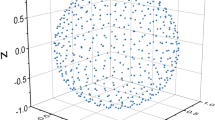Abstract
Crystal lattices are infinite periodic graphs that occur naturally in a variety of geometries and which are of fundamental importance in polymer science. Discrete models of protein folding use crystal lattices to define the space of protein conformations. Because various crystal lattices provide discretizations of the same physical phenomenon, it is reasonable to expect that there will exist “invariants” across lattices that define fundamental properties of the protein folding process; an invariant defines a property that transcends particular lattice formulations. This paper identifies two classes of invariants, defined in terms of sublattices that are related to the design of algorithms for the structure prediction problem. The first class of invariants is used to define a master approximation algorithm for which provable performance guarantees exist. This algorithm can be applied to generalizations of the hydrophobic-hydrophilic model that have lattices other than the cubic lattice, including most of the crystal lattices commonly used in protein folding lattice models. The second class of invariants applies to a related lattice model. Using these invariants, we show that for this model the structure prediction problem is intractable across a variety of three-dimensional lattices. It turns out that these two classes of invariants are respectively sublattices of the two- and three-dimensional square lattice. As the square lattices are the standard lattices used in empirical protein folding studies, our results provide a rigorous confirmation of the ability of these lattices to provide insight into biological phenomenon. Our results are the first in the literature that identify algorithmic paradigms for the protein structure prediction problem that transcend particular lattice formulations.
Preview
Unable to display preview. Download preview PDF.
Similar content being viewed by others
References
N. W. Ashcroft and N. D. Mermin. Solid State Physics. Holt, Rinehart and Winston, 1976.
D. G. Covell and R. L. Jernigan. Biochemistry, 29:3287, 1990.
K. A. Dill. Biochemistry, 24:1501, 1985.
K. A. Dill, S. Bromberg, K. Yue, K. M. Fiebig, D. P. Yee, P. D. Thomas, and H. S. Chan. Principles of protein folding: A perspective from simple exact models. Prot. Sci., 4:561–602, 1995.
A. S. Fraenkel. Complexity of protein folding. Bull. Math. Bio., 55(6):1199–1210, 1993.
M. R. Garey and D. S. Johnson. Computers and Intractability — A guide to the theory of NP-completeness. W.H. Freeman and Co., 1979.
A. M. Gutin and E. I. Shakhnovich. Ground state of random copolymers and the discrete random energy model. J. Chem. Phys., 98:8174–8177, 1993.
W. Hart and S. Istrail. Fast protein folding in the hydrophobic-hydrophilic model within three-eighths of optimal. To appear in Journal of Computational Biology, Spring 1996. Extended abstract in Proc. of 27th Annual ACM Symposium on Theory of Computation, May 1995.
M. Karplus and E. Shakhnovich. Protein folding: Theoretical studies of thermodynamics and dynamics, chapter 4, pages 127–195. W. H. Freeman and Company, 1993.
J. T. Ngo and J. Marks. Computational complexity of a problem in molecular structure prediction. Protein Engineering, 5(4):313–321, 1992.
M. Paterson, March 1995. Personal communication.
E. I. Shakhnovich and A. M. Gutin. Engineering of stable and fast-folding sequences of model proteins. Proc. Natl. Acad. Sci., 90:7195–7199, 1993.
A. Sikorski and J. Skolnick. Dynamice Monte Carlo simulations of globular protein folding/unfolding pathways. II. α-helical motifs. J. Molecular Biology, 212:819–836, July 1990.
J. Skolnick and A. Kolinski. Simulations of the folding of a globular protien. Science, 250:1121–1125, 1990.
R. Unger and J. Moult. Finding the lowest free energy conformation of a protein is a NP-hard problem: Proof and implications. Bull. Math. Bio., 55(6):1183–1198, 1993.
A. F. Wells. Three-dimensional nets and polyhedra. American Crystallographic Association, 1979.
Author information
Authors and Affiliations
Editor information
Rights and permissions
Copyright information
© 1996 Springer-Verlag Berlin Heidelberg
About this paper
Cite this paper
Hart, W.E., Istrail, S. (1996). Invariant patterns in crystal lattices: Implications for protein folding algorithms (extended abstract). In: Hirschberg, D., Myers, G. (eds) Combinatorial Pattern Matching. CPM 1996. Lecture Notes in Computer Science, vol 1075. Springer, Berlin, Heidelberg. https://doi.org/10.1007/3-540-61258-0_21
Download citation
DOI: https://doi.org/10.1007/3-540-61258-0_21
Published:
Publisher Name: Springer, Berlin, Heidelberg
Print ISBN: 978-3-540-61258-2
Online ISBN: 978-3-540-68390-2
eBook Packages: Springer Book Archive




